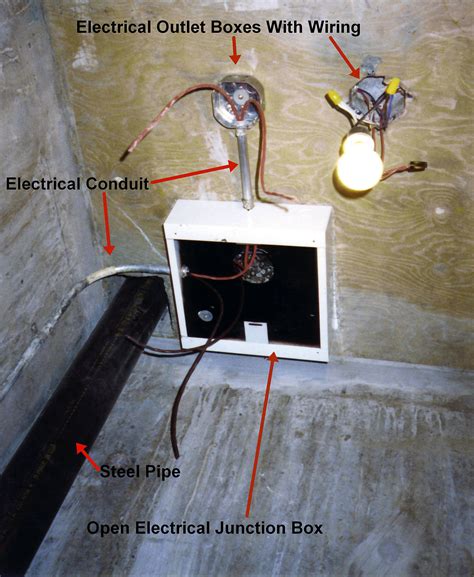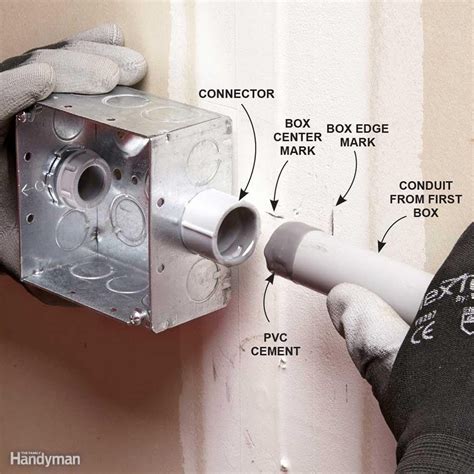after construction junction box Junction boxes protect electrical wires from damage, prevent shocks, and stop sparks from igniting flammable material nearby. To install . To wire a simple junction box, start by using wire strippers to remove approximately 3⁄4 inch (19 mm) of casing insulation from the end of each wire entering the box. .
0 · what is a junction box
1 · plastic junction box installation
2 · metal junction box
3 · junction box setup
4 · junction box installation
5 · how to make a junction box
6 · how to insert a junction box
7 · how to connect junction box
By following proper installation guidelines, such as selecting the appropriate junction box size, securing cables with clamps or connectors, and ensuring the presence of a .

Electrical boxes come in a seemingly endless variety of sizes and styles, including metallic (steel) versions, which requires grounding of the box. On the other hand, you can opt for nonmetallic versions (PVC, phenolic resin, or fiberglass), which do not require grounding of the box. Metallic boxes can be used with . See moreBefore getting started, it helps to understand the purpose and anatomy of an old work electrical box. An old work box is designed to be installed after the fact—on walls that . See moreIf you will be running live electrical wire to the new electrical box, it is absolutely essential that you turn off the circuit breaker that controls . See more
A junction box provides a safe, code-compliant space for housing cable connections for outlets, switches, or splices. They prevent potential electrical shocks, and keep sparks from spreading to flammable surroundings. Junction boxes protect electrical wires from damage, prevent shocks, and stop sparks from igniting flammable material nearby. To install . Follow these expert tips to install an electrical box into drywall or plaster without the need for wall studs or joists. Not all fixtures need to be attached to a wall stud or joist. .
An “old-work” electrical box is designed to be installed in sheetrock without nailing into a stud. Instead, the box has tabs that flip out and hold it to the drywall between studs. To start, use a stud finder to locate and mark the studs in .When an electrical circuit and electrical boxes are being added to an existing structure wires are snaked through building cavities to the desired fixture location and an old-work electrical box or "junction box" is installed to contain electrical .
One essential component of DIY wiring is the junction box, a crucial element that ensures safe electrical connections. In this blog, we’ll guide you through the process of safely installing and using junction boxes, providing . Follow these easy tips to make sure your electrical box installation looks professional and meets code requirements. typically are mounted to the sides of studs for stability. Whether nailed to the studs or screwed in with . If your house has visible wiring splices or if you need to add a new splice to extend a circuit, follow these simple steps to install a junction box.
what is a junction box
What Are the NEC Requirements for Junction Boxes and Enclosures? The NEC has outlined specific requirements for junction boxes to ensure the safety and proper installation of electrical wiring systems. An old work (retrofit) electrical box is a type of electrical box for outlets, light switches, and other devices that is installed after drywall has already been put in place. This allows you to retrofit an existing wall or ceiling without going through the hassle of removing drywall and plaster. A junction box provides a safe, code-compliant space for housing cable connections for outlets, switches, or splices. They prevent potential electrical shocks, and keep sparks from spreading to flammable surroundings. Junction boxes protect electrical wires from damage, prevent shocks, and stop sparks from igniting flammable material nearby. To install one, you’ll need to strip the ends off all the wires that will be in the box. To complete the electrical circuit, tie together the same-colored wires and hold them in place with wire nuts.
Follow these expert tips to install an electrical box into drywall or plaster without the need for wall studs or joists. Not all fixtures need to be attached to a wall stud or joist. Lightweight fixtures can hold up on plaster or drywall if you have a remodel electrical box.An “old-work” electrical box is designed to be installed in sheetrock without nailing into a stud. Instead, the box has tabs that flip out and hold it to the drywall between studs. To start, use a stud finder to locate and mark the studs in order to avoid them.
When an electrical circuit and electrical boxes are being added to an existing structure wires are snaked through building cavities to the desired fixture location and an old-work electrical box or "junction box" is installed to contain electrical splices and devices.
One essential component of DIY wiring is the junction box, a crucial element that ensures safe electrical connections. In this blog, we’ll guide you through the process of safely installing and using junction boxes, providing valuable insights for DIY enthusiasts. Follow these easy tips to make sure your electrical box installation looks professional and meets code requirements. typically are mounted to the sides of studs for stability. Whether nailed to the studs or screwed in with adjustable brackets, boxes on studs tend to stay in place for a long time. If your house has visible wiring splices or if you need to add a new splice to extend a circuit, follow these simple steps to install a junction box.
What Are the NEC Requirements for Junction Boxes and Enclosures? The NEC has outlined specific requirements for junction boxes to ensure the safety and proper installation of electrical wiring systems. An old work (retrofit) electrical box is a type of electrical box for outlets, light switches, and other devices that is installed after drywall has already been put in place. This allows you to retrofit an existing wall or ceiling without going through the hassle of removing drywall and plaster.
A junction box provides a safe, code-compliant space for housing cable connections for outlets, switches, or splices. They prevent potential electrical shocks, and keep sparks from spreading to flammable surroundings. Junction boxes protect electrical wires from damage, prevent shocks, and stop sparks from igniting flammable material nearby. To install one, you’ll need to strip the ends off all the wires that will be in the box. To complete the electrical circuit, tie together the same-colored wires and hold them in place with wire nuts.
plastic junction box installation
Follow these expert tips to install an electrical box into drywall or plaster without the need for wall studs or joists. Not all fixtures need to be attached to a wall stud or joist. Lightweight fixtures can hold up on plaster or drywall if you have a remodel electrical box.An “old-work” electrical box is designed to be installed in sheetrock without nailing into a stud. Instead, the box has tabs that flip out and hold it to the drywall between studs. To start, use a stud finder to locate and mark the studs in order to avoid them.When an electrical circuit and electrical boxes are being added to an existing structure wires are snaked through building cavities to the desired fixture location and an old-work electrical box or "junction box" is installed to contain electrical splices and devices. One essential component of DIY wiring is the junction box, a crucial element that ensures safe electrical connections. In this blog, we’ll guide you through the process of safely installing and using junction boxes, providing valuable insights for DIY enthusiasts.
Follow these easy tips to make sure your electrical box installation looks professional and meets code requirements. typically are mounted to the sides of studs for stability. Whether nailed to the studs or screwed in with adjustable brackets, boxes on studs tend to stay in place for a long time. If your house has visible wiring splices or if you need to add a new splice to extend a circuit, follow these simple steps to install a junction box.

buy pre-owned cnc machine
buyers black steel underbody truck box
Run new wires down the new conduit "back" to the box you tapped off of, and either splice in there, or continue through that box to wherever you're going. If you need more cubic inches, use a taller domed cover or mud ring or extension box.
after construction junction box|how to insert a junction box